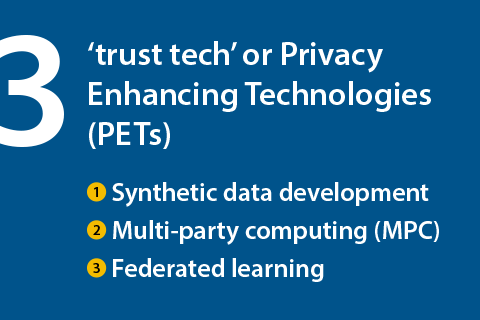How AI can be used at scale in transaction monitoring without sacrificing data confidentiality
The EU’s AML/CFT framework presents the banking industry with a dilemma: how can banks fulfil their KYC obligations, while also protecting the confidentiality of client data? According to INNOPAY’s Vince Jansen, three emerging types of ‘trust tech’ could provide the answer for transaction monitoring. “Artificial intelligence offers the potential for banks to achieve higher standards of compliance at lower costs, and trust tech could enable them to deploy AI at scale,” he says.
The EU’s anti-money laundering (AML) and countering the financing of terrorism (CFT) supervisory and regulatory framework presents a conflict of interests for the banking industry. On the one hand, to fulfil their responsibility as the first line of defence and avoid the risk of fines, banks are legally obliged to monitor clients (Know Your Customer), spot anomalies in transactions data and share information about potentially suspicious behaviour with governments and supervisory bodies. On the other hand, they have a legal responsibility to protect the confidentiality of client data. Today, this leaves the banking industry struggling with a €90bn cost problem in the EU alone.
The potential power of AI
So how can this conflict of interests be resolved? The topic of artificial intelligence (AI) seems to be on everyone’s lips nowadays, and there are a growing number of real-life use cases in which the adoption of AI is solving problems and giving all kinds of businesses a competitive advantage. Indeed, used at scale, AI offers the potential for banks to achieve higher standards of compliance at lower costs. After all, a correctly trained AI-based prediction model would be much more powerful in detecting otherwise indiscernible links or patterns in the complex web of transaction data – and ultimately require less human intervention – than the banks’ current data analysis methods.
The opportunities and risks of data pooling
When it comes to successful AI use cases, however, the crucial keyword is ‘training’. To achieve optimally accurate predictions and self-learning, an AI prediction model must be trained on huge volumes of data from multiple, dependable sources. In the ideal situation in the AML/CFT context, the data from all banks should be ‘pooled’ into a combined dataset.
This idea – the use or adoption of AI in a collaborative environment – isn’t new. In fact, it is even suggested by the EU. But as mentioned above, this concept of ‘data pooling’ makes it difficult for banks to guarantee that client data will be sufficiently protected and securely shared, without risks of security breaches. As a result, the use of AI at scale in the banking industry appears to have reached an impasse.
Emerging trust tech could overcome the impasse
At INNOPAY, we believe that the following three emerging types of ‘trust tech’ (sometimes also referred to as Privacy Enhancing Technologies or PETs) have the potential to play a role in the context of data pooling for transaction monitoring purposes:
- Synthetic data development: Synthetic datasets are generated based on lifelike hypotheses and repeatedly tested until they become good enough to be used in practice. This is a cost-effective method of training models while removing certain confidential or privacy-sensitive information.
- Multi-party computing (MPC): Parties share ‘copies’ of selected data with each other rather than sharing the complete data. Parties can see the outcomes of what they have put in, but cannot see other parties’ inputs or outcomes.
- Federated learning: Original datasets are not shared and combined at a centralised level. Instead, the data remains with each local provider, but the ‘general’ version can be continuously improved. This approach can be tailored and optimised for the local situation.
Which approach is most relevant and suitable depends on the specific situation. But what all three of these technologies have in common is that they enable data flows to be used for AI training and analysis purposes without compromising on data confidentiality and without the heightened data security risks associated with combining them into a single, centralised dataset.
Benefits for banks, governments, and society
Although these three types of trust tech are still in the very early stages of adoption, there is consensus that they could in theory enable banks to benefit from deploying AI at scale to comply with AML/CFT obligations, whilst at the same time protecting client data. After all, banks are no strangers to using innovative technology to solve problems and create new opportunities. Moreover, as the rapid growth of Open Banking illustrates, this is increasingly being done based on a collaborative approach and ‘ecosystem thinking’. Perhaps it is now time to apply the same mindset to data pooling so that banks, governments and society can benefit from the use of artificial intelligence to better prevent financial crime.
To discuss how trust tech could help you to take the next step in transaction monitoring, or any other issues relating to AI and payments, contact INNOPAY’s Vince Jansen.





